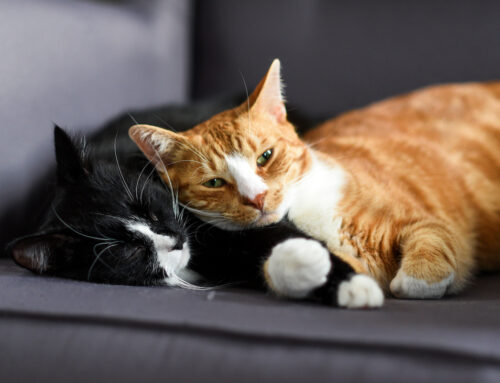We know you love your cat, but you may not be fully aware of just how cool your cat — and her overall species — really is. For example, did you know that cats have an extra organ that allows them to taste scents? Or that they developed meowing as a way to communicate exclusively with humans?
Clearly, there’s more to your little feline friend than meets the eye.
Here we’ve compiled some interesting cat facts about your feline friend.
Did You Know You’re Housing a Tiger?
“A house cat’s genome is 95.6 percent tiger, and they share many behaviors with their jungle ancestors,” says Layla Morgan Wilde, a cat behavior expert and the founder of Cat Wisdom 101.
Cats have a unique “vocabulary” with their owner — each cat has a different set of vocalizations, purrs, and behaviors. Cats have up to 100 different vocalizations — dogs only have 10.
Meowing is a behavior that cats developed exclusively to communicate with people. When a cat flops over and exposes his belly, it’s not always an invitation for a belly rub. A cat does this when he’s relaxed and showing trust. When cats hit you with retracted claws, they’re playing, not attacking.
Cats, like tigers, find it threatening when you make direct eye contact with them. Kneading — which some people refer to as “making biscuits” — is a sign of contentment and happiness.
The More You Know, Some More Facts About Kitty Cats
Cats are believed to be the only mammals who don’t taste sweetness.
Cats are nearsighted, but their peripheral vision and night vision are much better than that of humans.
Cats are supposed to have 18 toes (five toes on each front paw; four toes on each back paw). There are cats who have more than 18 toes. These extra-digit felines are referred to as being “polydactyl.”
Cats can jump up to six times their length.
Cats have 230 bones, while humans only have 206. Cats’ collarbones don’t connect to their other bones, as these bones are buried in their shoulder muscles. Cats have nearly twice the amount of neurons in their cerebral cortex as dogs.
Cats have an extra organ that allows them to taste scents on the air, which is why your cat stares at you with her mouth open from time to time.
Cats have the largest eyes relative to their head size of any mammal.
Cats make very little noise when they walk around. The thick, soft pads on their paws allow them to sneak up on their prey — or you! Cats’ rough tongues can lick a bone clean of any shred of meat.
Whiskers Help Cats Feel the World, and They Always Lead With The Right
Cats use their whiskers to “feel” the world around them in an effort to determine which small spaces they can fit into. A cat’s whiskers are generally about the same width as its body. (This is why you should never, EVER cut their whiskers.)
Cats walk like camels and giraffes: They move both of their right feet first, then move both of their left feet.
Though cats can notice the fast movements of their prey, it often seems to them that slow-moving objects are actually stagnant. Some cats are ambidextrous, but 40 percent are either left- or right-pawed.
Cats are crepuscular, which means that they’re most active at dawn and dusk. Cats are fastidious creatures about their “bathroom.” If you have more than one cat, you should have one litter box for each. Cats can spend up to a third of their waking hour’s grooming. Your cat’s grooming process stimulates blood flow to his skin, regulates his body temperature, and helps him relax.
Cats live longer when they stay indoors.
Better To Switch a Cat’s Food Than Wait Your Picky Cat Out
Cats will refuse unpalatable food to the point of starvation. Despite popular belief, many cats are actually lactose intolerant. Female cats have the ability to get pregnant when they are only 4 months old!
Grapes and raisins, as well as onions, garlic, and chives, are all extremely harmful foods for cats. They can wreak havoc on your cat’s gastrointestinal system and can cause anemia.
If you keep your cat active during the day, he will sleep better at night. If you’re not free-feeding your cat, you can also help her get a good night’s sleep by providing her with a substantial evening meal.
The effects of nepetalactone — the chemical in catnip that can make cats crazy — wears off within 15 minutes, and won’t surface again for a few hours, even if your cat remains in sniffing distance.
Love Your Cat, and They’ll Love You Back
These amazing creatures are full of love to give. Take care of them, and they will give you a lifetime of love in return.
If you’re looking for a vet to keep your kitty healthy contact us here at Animal Care Center.






